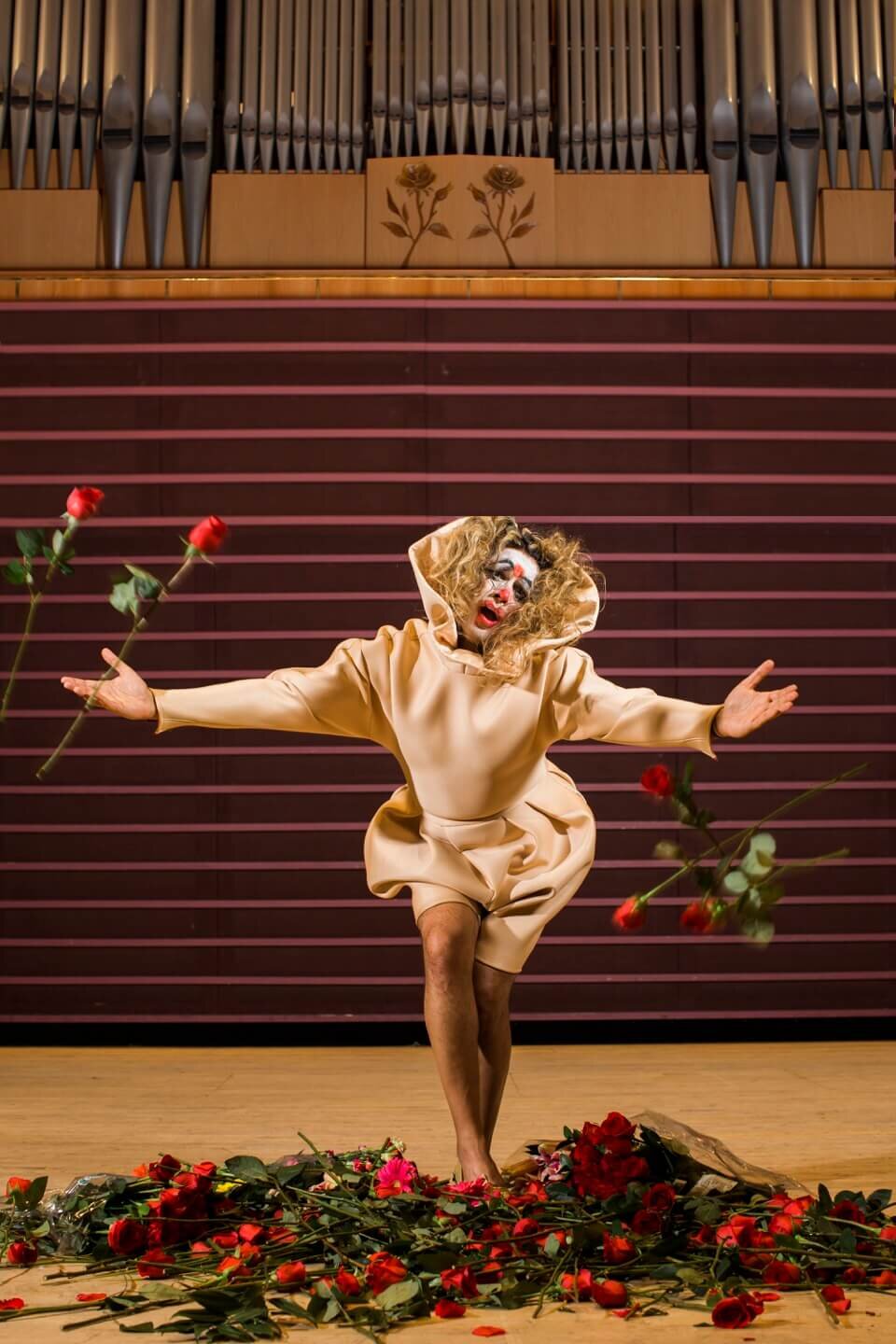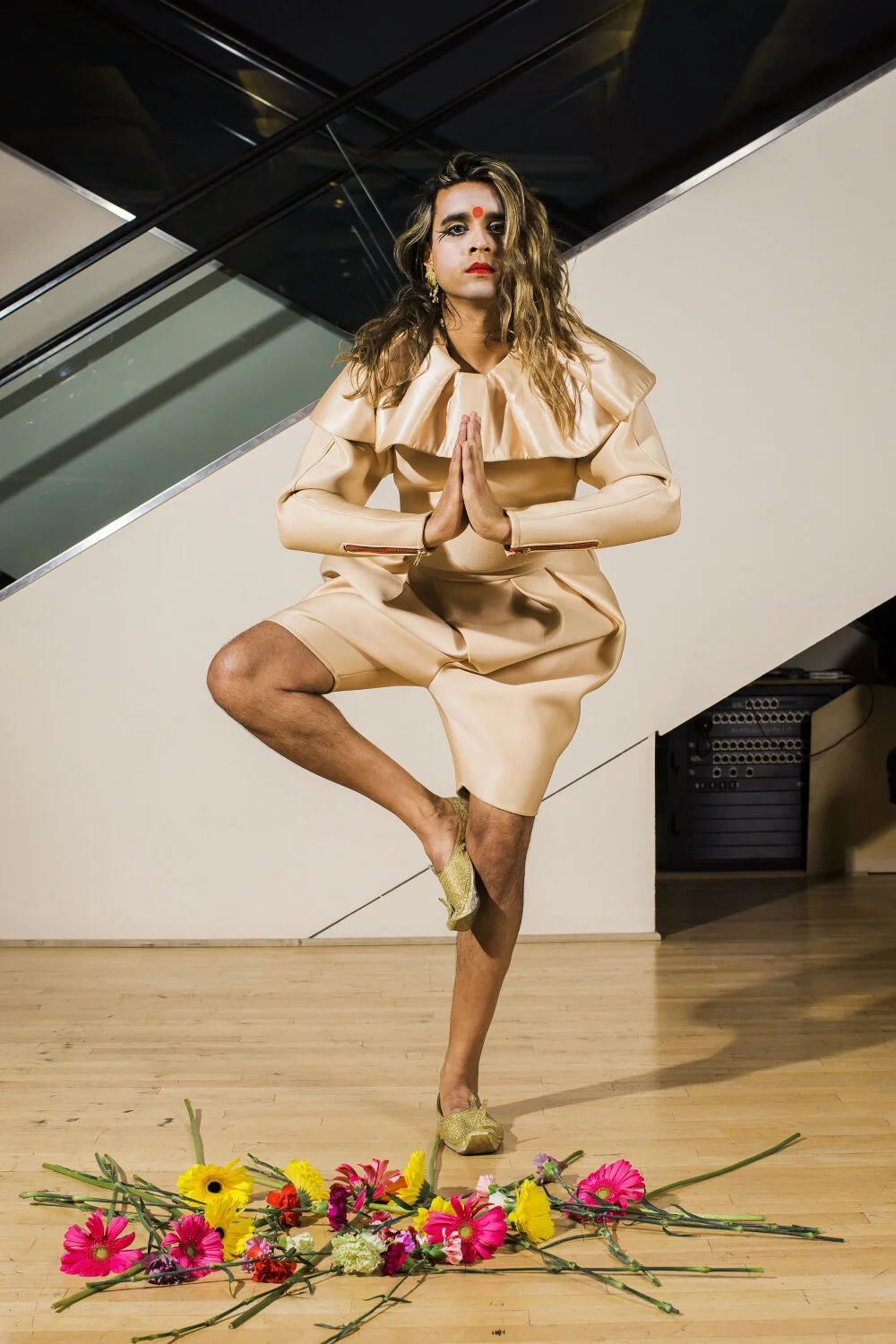Vivek Shraya's Trauma Clown photo series probes the commodification of personal pain
The writer tracks her own trajectory at the SUM Gallery, as part of the Capture Photography Festival
Vivek Shraya, Trauma Clown.
SUM Gallery presents Trauma Clown to July 1. Opening-night receptions April 1 and 2 are sold out; an online artist talk April 3 at 3 pm is still taking registration. Advance appointments are required to view the exhibition; you can book visits here. Find COVID-19 safety guidelines here.
SATIRE AND SUFFERING come together in a new self-portrait series by visual artist, author, and musician Vivek Shraya.
Meant to be viewed in order in the new show Trauma Clown at the SUM Gallery, the photographs shot by Zachary Ayotte track Shraya’s gradual rise, as a trans woman of colour, to acclaim—and the cost of that rise. The exhibit is part of the 2021 Capture Photography Festival Selected Exhibition Program.
From the first image, Lovesick Clown, where a forlorn Shraya plays her guitar onstage, her makeup and hair become more and more chaotic and outrageous, until we see her in full sad-clown face, miming her pain, with a sea of red-pink roses, thrown by an unseen audience, at her feet.
“If you could see all these people literally throwing flowers at me!” the affable artist says with a laugh over the phone from her home in Calgary, where she is an assistant professor of creative writing. “Surprisingly it was a lot of fun to do—because I don't understand what the parameters are for visual art. I don't know what Heather’s Pick is for visual art.
“A lot of my brand is tied to how I look, and there’s pressure to present a high femme persona,” Shraya adds. “This is the opposite: something that’s not invested in being pretty. Part of me was playing a character I don't get to play, and playing that character in a hyperbolic way.”
As fun as it may have been to shoot, the photo series had far more serious inspiration. It came to Shraya as she was touring and performing readings during the wave of success that met her 2018 nonfiction book I’m Afraid of Men—a story of how masculinity was imposed on her as a boy, drove the bullying she received for being queer and nonwhite as a teen, and continues to haunt her as a woman.
Vivek Shraya, Immigrant Clown.
“It wasn’t an easy book to write,” she says of the national bestseller. “It was traumatic, in a way, to go back to those experiences. I found myself tracking how much trauma I was showing in my work and how it was being received. And I saw that the more trauma I exposed publicly, the more there seemed to be support, not just on the audience level but institutional level.”
It was around that time that she casually half-joked in conversation with a friend over the phone that she was becoming a “trauma clown”.
And so the self-portrait project began to take shape, working with collaborator Ayotte and makeup artist Alanna Chelmick. She knew just what outfit to pull out of her closet: L’Uomo Strano designer Mic. Carter’s high-fashion, neoprene number that happens to have a slightly clownlike frilled collar and playful shorts instead of a skirt. The costume slowly reveals its true splendour over the course of the series. The flowers became the colourfully potent symbol for the Trauma Clown’s rising popularity, growing from three in the first shot to the small mountain in the sixth.
Its approach might rely on exaggeration, but the series ties directly into Shraya’s own trajectory—from her beginnings in music, to the early artistic output alluded to in Coming Out Clown and Immigrant Clown, to her full celebration as a bestselling author. At the same time, the photos address the viewer directly, making us question our own appetite for work that reveals the oppression or suffering of others—especially marginalized others—and the way that’s been commodified.
It’s not Shraya’s first foray into photography and self portrait. “Trisha”, her acclaimed 2016 series of diptychs, mined equally personal ground, picturing Shraya dressed up to re-enact vintage photographs of her beloved mother.
Those artworks could be looked at singularly or out of order, she points out, but she prefers you see “Trauma Clown” in the chronology on the SUM walls.
Meanwhile, in her own career, she continues to push for the freedom to write about subjects outside of her darker experiences as a trans woman.
“Marginalized artists should have the right to choose to write what they want,” she says, adding she met with resistance when she tried to shop a children’s book about raccoons. “To support diverse voices, it means we have to support what these diverse voices want to say.”
For Shraya, whose debut theatrical work, the semi-autobiographical How to Fail as a Popstar, was just published by Vancouver’s Arsenal Press, she won’t shy away from baring herself altogether anymore. But she questions herself more about it. “I ask myself, ‘Am I feeling pressure to do this?’” she says. “I’m trying to figure out, if I’m disclosing something traumatic, why I’m doing it.”
















